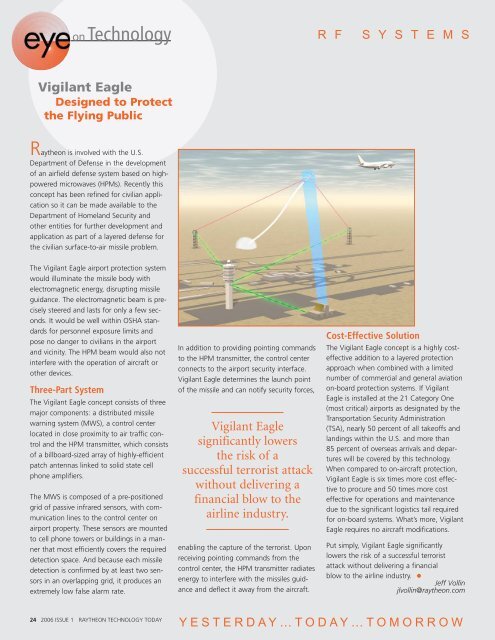ACHIEVING MISSION ASSURANCE - Raytheon
ACHIEVING MISSION ASSURANCE - Raytheon
ACHIEVING MISSION ASSURANCE - Raytheon
You also want an ePaper? Increase the reach of your titles
YUMPU automatically turns print PDFs into web optimized ePapers that Google loves.
Vigilant Eagle<br />
Designed to Protect<br />
the Flying Public<br />
<strong>Raytheon</strong> is involved with the U.S.<br />
Department of Defense in the development<br />
of an airfield defense system based on highpowered<br />
microwaves (HPMs). Recently this<br />
concept has been refined for civilian application<br />
so it can be made available to the<br />
Department of Homeland Security and<br />
other entities for further development and<br />
application as part of a layered defense for<br />
the civilian surface-to-air missile problem.<br />
The Vigilant Eagle airport protection system<br />
would illuminate the missile body with<br />
electromagnetic energy, disrupting missile<br />
guidance. The electromagnetic beam is precisely<br />
steered and lasts for only a few seconds.<br />
It would be well within OSHA standards<br />
for personnel exposure limits and<br />
pose no danger to civilians in the airport<br />
and vicinity. The HPM beam would also not<br />
interfere with the operation of aircraft or<br />
other devices.<br />
Three-Part System<br />
onTechnology<br />
The Vigilant Eagle concept consists of three<br />
major components: a distributed missile<br />
warning system (MWS), a control center<br />
located in close proximity to air traffic control<br />
and the HPM transmitter, which consists<br />
of a billboard-sized array of highly-efficient<br />
patch antennas linked to solid state cell<br />
phone amplifiers.<br />
The MWS is composed of a pre-positioned<br />
grid of passive infrared sensors, with communication<br />
lines to the control center on<br />
airport property. These sensors are mounted<br />
to cell phone towers or buildings in a manner<br />
that most efficiently covers the required<br />
detection space. And because each missile<br />
detection is confirmed by at least two sensors<br />
in an overlapping grid, it produces an<br />
extremely low false alarm rate.<br />
In addition to providing pointing commands<br />
to the HPM transmitter, the control center<br />
connects to the airport security interface.<br />
Vigilant Eagle determines the launch point<br />
of the missile and can notify security forces,<br />
Vigilant Eagle<br />
significantly lowers<br />
the risk of a<br />
successful terrorist attack<br />
without delivering a<br />
financial blow to the<br />
airline industry.<br />
enabling the capture of the terrorist. Upon<br />
receiving pointing commands from the<br />
control center, the HPM transmitter radiates<br />
energy to interfere with the missiles guidance<br />
and deflect it away from the aircraft.<br />
R F S Y S T E M S<br />
Cost-Effective Solution<br />
The Vigilant Eagle concept is a highly costeffective<br />
addition to a layered protection<br />
approach when combined with a limited<br />
number of commercial and general aviation<br />
on-board protection systems. If Vigilant<br />
Eagle is installed at the 21 Category One<br />
(most critical) airports as designated by the<br />
Transportation Security Administration<br />
(TSA), nearly 50 percent of all takeoffs and<br />
landings within the U.S. and more than<br />
85 percent of overseas arrivals and departures<br />
will be covered by this technology.<br />
When compared to on-aircraft protection,<br />
Vigilant Eagle is six times more cost effective<br />
to procure and 50 times more cost<br />
effective for operations and maintenance<br />
due to the significant logistics tail required<br />
for on-board systems. What’s more, Vigilant<br />
Eagle requires no aircraft modifications.<br />
Put simply, Vigilant Eagle significantly<br />
lowers the risk of a successful terrorist<br />
attack without delivering a financial<br />
blow to the airline industry.<br />
Jeff Vollin<br />
jlvollin@raytheon.com<br />
24 2006 ISSUE 1 RAYTHEON TECHNOLOGY TODAY YESTERDAY…TODAY…TOMORROW

















